Display screen + Sound + Stage
Textual content by Prachi Sibal. Pictures by Rose Tommy.
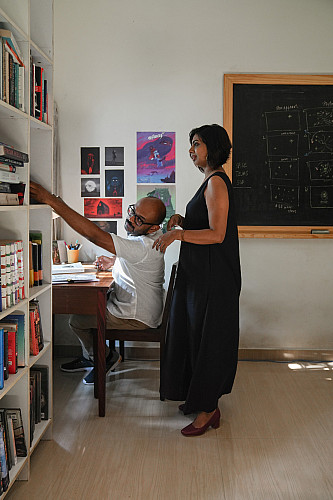
Tina and Pratheek Thomas at their workspace of their Kochi residence.
Tina and Pratheek Thomas had been born on the identical day, 4 years aside. And that is simply one of many many coincidences that ties them collectively. Each storytellers at coronary heart, the 2 first exchanged glances whereas furiously scribbling away of their particular person notebooks on a prepare journey from Bengaluru to Kochi in 2010. On the time, she was writing a script for a tv present, he was engaged on a comic book ebook. They might get married within the following yr.
By happenstance, their small enterprise, a comic book ebook publishing home, was launched on February 14, 2014. They known as it Studio Kokaachi, after a not-so-beloved monster that’s a part of Malayalam folklore — and who they had been launched to as kids. Each Tina and Pratheek preserve that the kokaachi has been misrepresented in widespread tradition and, in actuality, shouldn’t be a scary monster as it’s generally believed. They usually have taken it upon themselves to unfold phrase about this little-known side of the imaginary monster’s persona.

The kokaachi monster types the emblem for Studio Kokaachi.
Studio Kokaachi isn’t Pratheek’s first brush with the world of comedian books. A comic book ebook fan by his childhood years, he graduated from NID (Nationwide Institute of Design), Ahmedabad and went on to work at ISKCON (Worldwide Society for Krishna Consciousness) in Bengaluru. “I used to be working with the design wing and was concerned in a venture pertaining to country-wide theme parks that had been to have Krishna as a central character,” he says. An unlucky layoff and months with no job again in 2008 led him to embrace his past love, storytelling.
Manta Ray Comics — a partnership with buddy and fellow comedian ebook nerd Dileep Cherian — was thus born, with its first ebook Hush popping out in January 2011. “My brother is an advert film-maker and he had an concept for a brief movie. I wished to adapt it into a comic book so he might pitch it to producers,” Pratheek says in regards to the first title.
In 2012, when Tina was working at Wipro in Bengaluru, she remembers Manta Ray being “just like the child at residence”. Her first caricature appeared in The Small Image, a weekly contribution by Manta Ray Comics in Mint, in the identical yr. Commenting on social and cultural points, it ran for greater than three years.

The duvet of Mixtape Vol. 2 that was republished by Studio Kokaachi in 2014.
By the way, it was with this outing that Manta Ray first gathered acclaim; helmed by Cherian, it stood out significantly for its simplistic out-of-the field themes and artworks. In a market saturated with mythological and superhero tales, this was genre-bending.
Manta Ray revealed Mixtape Vol. 1 in April 2013 — it comprised 4 particular person black-and-white graphic narratives, illustrated by a mixture of upcoming and well-known artists. Every was priced at a mere 55 rupees for the digital model. Mixtape Vol. 2 — in an identical format — adopted on the finish of the yr: the result was 5 quick tales revolving round eclectic narratives; these included a person chasing a pickpocket, a biting satire on social media and a story of affection gone flawed.
However the couple quickly realised that creating and publishing comedian books isn’t straightforward cash. It did, nevertheless, make them a distinct — and extra profitable — business, one which they’d by no means imagined making an attempt their hand at.
Onto The Silver Display screen
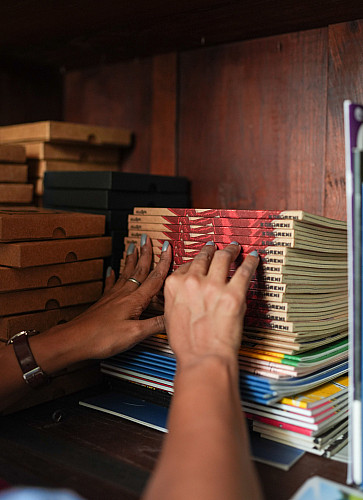

Left to Proper: the Mixtape sequence; a collage of frames from the animated sequences within the 2015 Tamil movie OK Kanmani and its 2017 Hindi remake OK Jaanu.
The launch of Manta Ray’s Mixtape Vol. 2 at Malayalam film-maker Aashiq Abu’s Cafe Papaya in Kochi led to a proposal by Abu, who was eager on collaborating with the duo for his 2014 Malayalam movie Gangster. Calling themselves Studio Kokaachi now, their first steps into the world of movies led to a whopping 11 minutes of animation that coated the prologue and the climax.
“Aashiq Abu additionally wished us to jot down screenplays for a brand new venture. It didn’t find yourself taking place however we had already moved to Kochi from Bengaluru, to work with Abu,” remembers Tina. Studio Kokaachi’s first comedian Mixtape Vol. 3 would solely be revealed in October 2016. This could be adopted by An Autobiografly, an autobiography of a housefly, and the accordion-style Matchbox Comix Vol. 2. The big gaps between releases is attributed to their ventures being self-funded.
For Mani Ratnam’s Tamil movie OK Kanmani (2015), Studio Kokaachi created each 2D and 3D animated sport sequences that supported the protagonist’s — a gamer — character arc in addition to the 2D finish credit. For the Hindi remake OK Jaanu (2017) the 3D sequences had been performed in collaboration with Splat Studio, and the 2D sequences with Dreamcatcher Studios, whereas the opening credit score sequences had been created in collaboration with Plexus Movement.

A piece in progress: pages from Sound Of Her Silence, one of many tales within the yet-to-be-released Mixtape Vol. 4.
Quickly after, actor Neil Bhoopalam found Mixtape Vol. 1 at a restaurant in Goa. He confirmed it to director Akshat Verma, who was considering making a graphic novel primarily based on their upcoming movie, Kaalakaandi (2018), additionally starring Saif Ali Khan, as publicity materials for it. Though it didn’t materialise, Studio Kokaachi was roped in for the movie’s title sequence in 2017.
Breaking Into OTT
Gully Boy (2019, on Vimeo): the opening titles by Studio Kokaachi
Tina and Pratheek stepped into the OTT title credit house with Lust Tales, the 2018 Netflix anthology produced by Ronnie Screwvala’s RSVP Motion pictures and Ashi Dua’s Flying Unicorn Leisure. Since then they’ve created the title credit for six extra productions for Netflix — the Tamil limited-edition anthology movie Paava Kadhaigal (2020), the Hindi-Telugu bilingual Pitta Kathalu (2021) and the Hindi-language productions, Ghost Tales (2020), Ankahi Kahaniya (2021), Ajeeb Dastaans (2021) and the just lately launched Lust Tales 2. “For each the Lust Tales, we used parts from the varied movies and stitched a story for the title credit. We tried to evoke the temper — the world and the characters are what we will mess around with. Paava Kadhaigal includes 4 quick movies about honour killing and the title credit provide you with a glimpse of the temper that lies forward. The movies had been very darkish. The opening credit function the journey of a lady from delivery to motherhood. We linked all of the illustrations utilizing the color crimson. Crimson performs an necessary half in a lady’s life — from menstrual blood to sindoor and the marriage sari,” says Tina.
Movie-maker Zoya Akhtar initially reached out to them to animate the emblem for Tiger Child Movies, her manufacturing home that was launched in 2019 with Gully Boy, after which requested if they’d do the title sequence for the movie as properly. “Once we bought known as for Gully Boy we didn’t realise how large it was,” says Tina.


Left to Proper: a shortlist of title fonts for Gully Boy; the ideation pocket book for the movie’s title sequence.
From animated sequences in OK Kanmani and Abu’s Gangster to animated typography in Gully Boy, their repertoire was steadily increasing. Gangster had a graphic novel-inspired type. OK Kanmani has stylised, sport sequence-like animation. Lust Tales has a minimal design type. They’ve additionally performed the animated brand for a Hollywood studio that hasn’t been launched but.
Regardless of the rise within the scope and amount of their work, Studio Kokaachi remains to be simply made up of Tina and Pratheek. Graphic designers, illustrators, artists and animators come on board primarily based on the calls for of the tasks they tackle. Their workplace premises have remained shut for the reason that pandemic. The couple now works out of their residence the place they dwell with their 4 rescue canine. “Each of us are writers and storytellers, we aren’t illustrators or animators. We conceptualise, write and supply the mandatory route to the tasks, and collaborate with animators and artists for the remainder of our wants,” says Pratheek, including that they’ve gone from working with animation studios to now additionally handpicking freelance artists for particular tasks now. “We work with studios or freelancers primarily based on the amount of labor. OK Kanmani and Gangster had been exceptions the place we had been going past our mainstay — title credit — and creating longer animation sequences. We would have liked studio help to render them inside our three-month deadline.”
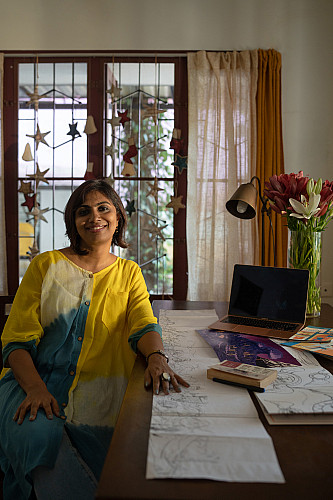
Tina with sketches for A Thousand Years, an upcoming comedian ebook.
Standing Out In The Muddle
Cracking an idea for a movie or sequence stays their largest problem and may take weeks. Not everybody desires animation within the title sequence or is keen to share footage from the movie for a similar. “For The Empire, the Disney + Hotstar net sequence, we offered 10 ideas, and all of them had been rejected by the makers. We had run out of concepts after which at midnight, I wrote down the phrase “Empire” on a blackboard. The phrase has six letters and there have been six Mughal emperors. It was like an epiphany,” says Pratheek in regards to the credit score sequence the place silhouettes of the faces of six Mughal emperors flip to disclose the title of the sequence.
Studio Kokaachi hopes to veer in a brand new inventive route with each venture, however they select to avoid dwell motion. The credit for the Indian Trendy Love anthologies, which premiered on Amazon Prime in 2022, performed with inventory photos, whereas these for Rocket Boys (2022-’23) had been hand-drawn with minimal animation, an enormous departure in type from their earlier work. “We don’t have the talent set for dwell motion and it is not sensible for us to outsource it,” he says. “The opposite problem is coping with manufacturing homes that come to us with out understanding the restrictions of our discipline. For instance, provided that they had been hand-drawn, we might replicate Jim Sarbh and Ishwak Singh’s facial options solely to a sure extent,” they are saying, referring to the Rocket Boys opening credit.
However this SonyLIV net sequence turned out to be their large break. “With Lust Tales, folks seen us however we didn’t get requires too many tasks. However when actors started to tag us on social media after Rocket Boys, there was a sudden explosion of curiosity,” Pratheek explains. Their work had now reached important mass.
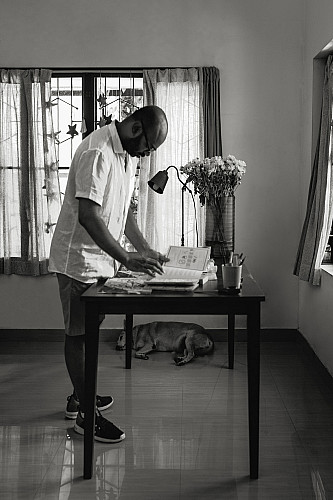
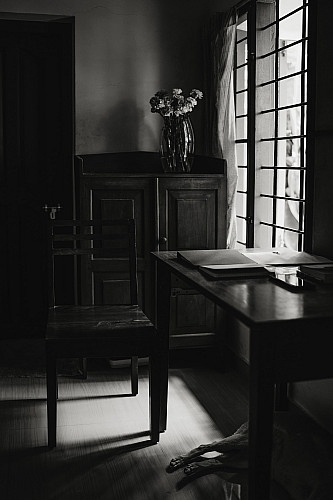
Left to Proper: Pratheek at work; his writing desk.
“We don’t fairly know the way it occurred however we now have one way or the other turn into synonymous with title sequences. We aren’t in Mumbai. We don’t exit and pitch. We aren’t very energetic on social media –– we aren’t even on WhatsApp,” he says, including that the conceptualisation and execution of title sequences as mini movies are in sync with their fundamental talent set as storytellers.
Of their seventh yr of making title sequences, Studio Kokaachi is awaiting the discharge of their twenty fifth venture, Pippa, a movie set through the 1971 Indo-Pak battle. Then there’s Shiladitya Bora’s Bhagwan Bharose, the twenty fifth UK Asian Movie Competition’s closing movie, which bagged the Finest Movie award in Might. “We’ve additionally created an animated brand for Earthsky Footage (Ashwiny Iyer Tiwari and Nitesh Tiwari’s manufacturing home),” says Tina.
The Artwork Of Credit score Sequences

Pratheek’s web page layouts for Hush.
Title sequences in Indian movies have integrated — from animation, handwritten slides and catchy music for aeons now. They’ve been a technique to maintain audiences entertained.
In earlier occasions, the tone, music and textual content typically conveyed the emotion of the upcoming movie and ready viewers for what was in retailer. “I personally desire credit the place somewhat little bit of the film is proven. It captures the curiosity of the viewer,” says Bollywood buff Dhruv Somani. Earlier, he says, viewers wouldn’t thoughts lacking the top credit score sequences however with film-makers selecting to run elaborate finish credit in recent times, that is not the case. “In Bollywood, that is additionally the place you’ll generally discover the hot-ticket quantity that’s widespread with the lots,” chimes in Puneet Rakheja, who used to run the weblog Taking Credit score in 2013-’14, with the intention of decoding credit score sequences in movies.
“Although it’s not recognised by the Academy but, the title sequence is an artwork kind in its personal proper. The opening credit are the primary visuals you meet in a movie. They’ll carry out numerous roles — as a story system that pushes the story alongside, an introduction to the characters and big-ticket actors, and so forth. These days, some are utilizing these title sequences as a technique to move on refined clues about an anticipated plot; as an illustration, in Sport of Thrones, on the top of its fervour, there have been loads of blogs and movies dedicated to the now iconic title sequences,” provides Rakheja.
The credit score sequences in Bollywood movies and OTT sequence largely stay in English, with the title of the movies being spelt out in Hindi and Urdu at occasions. Down South, the credit have all the time been displayed within the native languages. “In Kollywood, all of the credit would seem in Tamil and solely the names of the important thing solid and crew could be talked about in English. The background music is usually punctuated with dramatic silence for giant names like, say, Okay. Balachander,” says film-maker and educational Okay. Hariharan. He believes simplistic titles are the best way to go and brings up Sholay (1975) for example, for its use of fundamental title playing cards — names handwritten on playing cards and photographed — that had been removed from ornate and but efficient. “There isn’t any splendid credit score sequence. There are efficient or ineffective title sequences,” factors out Rakheja.
And standout sequences have stayed with audiences by the years.

Within the 1978 Amitabh Bachchan-starrer Don, the pre-credits scene has him throwing a briefcase on the goons. It explodes and leads us to the credit score sequence, which opens with a battle. Introduced as colored movie negatives, the credit, accompanied by the theme track, set the tone for the high-paced chase that’s about to observe.
Shivendra Singh Dungarpur, film-maker, movie historian and founding father of the Movie Heritage Basis, cites the instance of the 1966 movie Teesri Manzil the place the opening credit finish with a lady falling off the third storey of a constructing in an effort to construct suspense.
“The sooner title sequences principally made use of title playing cards. The 1936 Devdas used an artwork deco typeface – that was widespread then – towards a black background. Within the 1955 model, the credit seem because the pages of a ebook are flipped,” says Rakheja. “The outstanding expressionist body of a pair of eyes and a dozen palms within the 1957 movie Do Aankhen Barah Haath was placing; the opening sequence makes use of 12 handprints as a canvas for the credit.”
Somani recounts the presence of background music within the credit of black and white movies of the ’50s. “When Eastmancolor got here into the image, title credit turned extra eye-catching. The ’80s noticed a number of the most memorable sequences because of Nasir Hussain, Hrishikesh Mukherjee, Raj Khosla and the Ramsay Brothers,” he says.

A double unfold from Hush.
The credit score sequences had been typically employed to create an environment of suspense. “These for low-budget horror movies by the Ramsay Brothers introduced with them a sure curiosity and evoked a temper that might lead viewers into the movie with out bringing in any parts of gore. Raja Nawathe’s 1965 thriller Gumnaam, then again, had blood splattered throughout the display, blatantly denoting a way of thriller,” he says.
Quick-paced sequences with acceptable music had been for thrillers and horror whereas animation was reserved for comedies. In Sai Paranjpye’s Katha (1983), the credit score sequence tells us of the hare-and-tortoise fable with hand-drawn illustrations. It units a comic book tone and stays a thread by the movie, reoccurring on the finish.
The Results Of Digitalisation
The digital age that set its stamp on the 2000s noticed a brand new sophistication creep into title sequences. The manufacturing worth was higher and music was generally commissioned particularly for the credit score reels. Based on Rakheja, there has additionally been a shift in direction of creating larger-than-life imagery. He cites Baahubali 2: The Conclusion (2017) for example; it used its title credit as a plot system that gave viewers a glimpse of key occasions from the earlier movie. “Its title sequence animated scenes from the primary movie which lent them a larger-than-life really feel,” he says.

From the ’90s onward, there have been solely a handful of references that they discuss. “In current occasions, Farah Khan began the development of making finish credit score sequences that the viewers would keep again to observe, we see it in Primary Hoon Na and Om Shanti Om,” says Somani, referring particularly to the latter, the place a number of of the solid and crew, together with technicians and spot boys, make an look. The sequence closes with the grand entry of the director in an auto. It was a tribute to the solid and crew of the movie that suggestions a hat to the glory days of the Hindi movie business.
The top credit of Zoya Akhtar’s Luck by Probability (2009) additionally made a mark for its innovation. The credit score reel that the movie closes with includes a single lengthy shot of Konkona Sen Sharma in a black-and-yellow taxi, with town of Mumbai within the backdrop. From a starkly completely different style, Anurag Kashyap’s Gangs of Wasseypur (2012), with its rugged, textured title playing cards, and Black Friday (2004), the place the title of the movie foregrounds the smoke-filled photos of the 1993 Bombay blasts, are equally memorable.
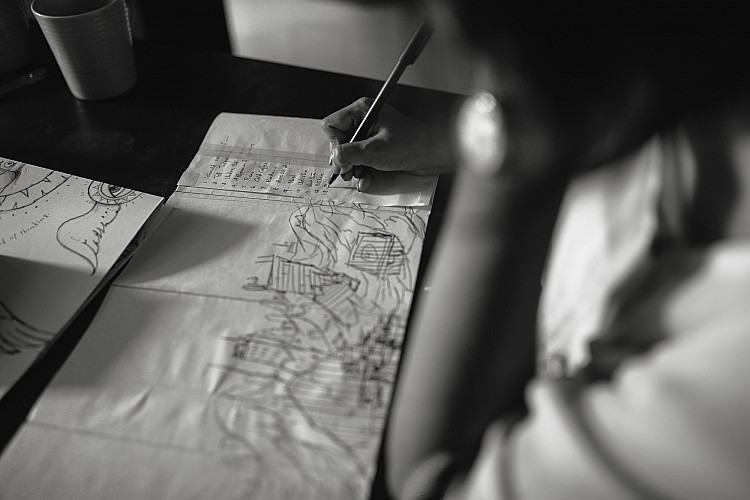
A tough sketch from A Thousand Years.
Then there’s the flip facet to digitally produced credit score sequences. Whereas embracing the digital instruments out there to create revolutionary and high-quality titles, most critics admit that the non-public contact is slowly disappearing. “All credit score sequences have began trying the identical. The creative interpretation is misplaced. Because it was not a straightforward job earlier, everybody considered revolutionary, authentic concepts to make them stand out,” Dungarpur says. “It’s the identical with movie posters, you’ll be able to’t match the hand-drawn ones from the early days. Additionally, when was the final time you noticed a movie’s interval being introduced with a bang?” says Dungarpur, who has been sustaining a private archive of the ending pictures — particularly, “The Finish” frames –– of Indian movies.
The Resurgence
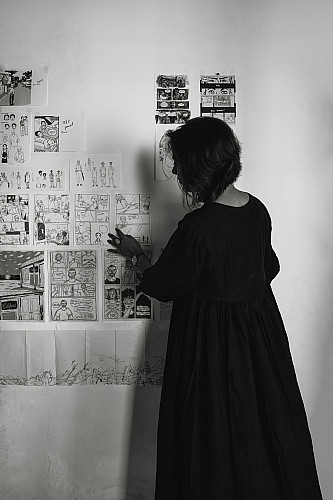

Left: Tina assesses tough sketches from Mixtape Vol. 4 and A Thousand Years.
A major development that has emerged with OTT movies and sequence is the outsourcing of credit score sequences to studios and producers past the silos of movie circuits. With OTT platforms developing with new releases each week and competing for viewers consideration, the pie is turning into bigger and there’s a bit for everybody.
In consequence, a variety of VFX companies have sprung up. Mumbai-based Plexus Movement, greatest identified for his or her title credit for each the seasons of Netflix’s Sacred Video games (2018-’19), Gangs of Wasseypur and Offended Indian Goddesses (2015), was additionally born in 2014. Extra just lately, Koffee With Karan (2004-’22) outsourced its credit score sequence to the Chennai-based Whoa Mama Design. Mumbai-based Harkat Studios, launched in 2017, has created title sequences for Bombay Begums (2021), Trial by Fireplace (2023) and Weapons and Gulaabs (2023), all of that are viewable on Netflix.
“We’ve performed credit for 2 Tamil movies however they had been over six years in the past. Dharma Productions bought in contact with us after taking place to see our model movies and edits on social media. They had been taking an opportunity,” says Shaun D’Sa, co-founder and artistic head, Whoa Mama Design. He provides, “Karan (Johar) favored the ideas that we shared. He was eager on a red-carpet scene. We labored on the storyboard, scripts, choreography and set design, and shot the sequence on the YRF Studio in Mumbai.”
The early work of Vijesh Rajan, earlier than he based Plexus Movement, consists of Gangs of Wasseypur, OK Kanmani, and MTV India’s The Dewarists (2011-’16) and Deliver on the Night time (2012). With Plexus Movement, he went on to supply atmospheric title sequences for one more Kashyap movie Raman Raghav 2.0 (2016), moreover miniseries like Ghoul (2018) and Leila (2019).
Rajan’s strategy to Gangs of Wasseypur was novel and tried to offer a contact of a Western, albeit within the heartlands of India. “I noticed a lot grit and texture on set. I wished the sequence to mirror that and the credit arrange the story of the place and the folks. The music needed to point out that it’s a harmful place to be, that the persons are harmful. We determined to go along with a big textured typeface,” he says, recalling how they’d rub sheets of paper with the title textual content on the bottom for the rugged, aged look. “We’d crumple paper after which scan it. For over 10 days, at Kashyap’s workplace in Mumbai, we had been simply rubbing paper throughout completely different surfaces to get the suitable texture. No two frames regarded the identical or had the identical texture,” he shares.

“When Plexus was engaged on Netflix’s Decoupled, the administrators got here with a short that clearly said the necessity for one thing recent for every episode. When a pair splits up, it’s not simply them, all their belongings get break up up too. We got here up with eight executions of the title sequence. A unique object within the opening credit of every of the eight episodes alludes to the separation by shifting away from its counterpart,” Rajan provides.
Sacred Video games, one other early piece of labor by Plexus, acquired rave critiques for the music — by Alokananda Dasgupta — employed in its title credit. Right here, the mandala and the haunting music creates a palpable stress. “Every episode has its distinctive mandala with parts from Hindu mythology embedded in it. It’s vibrant to start with after which the color begins to fade away. It signifies the underlying darkness that’s unleashed because the storyline progresses. We had been advised it must have some angst. That’s after we began doing these sharp edits,” he says of the considering behind the sequence.
With the sequence, Rajan’s staff tried to beat the system; particularly, the Skip Intro choice on OTT platforms. They achieved this by creating title sequences that modified with each episode, a stratagem that they’d replicate for Decoupled in 2021. The Skip Intro function works towards the animation artists. It additionally creates a brand new set of challenges, of bringing in selection with every episode. Lending the correct quantity of drama to the titles is important; they need to not overshadow the precise content material or reveal spoilers. Titles seem at a quicker velocity these days — you’ll be able to search for the credit on-line and therefore the titles serve a extra aesthetic and fewer useful goal now. However, Rajan believes that partaking credit are right here to remain. The skip choice on OTT platforms might not be a deal-breaker. “It pressurises studios to be extra inventive,” he says.
Surging Forward

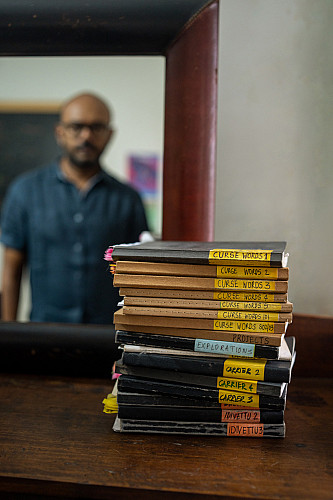
Studio Kokaachi’s journey with credit score sequences and comedian books isn’t going to finish anytime quickly. Their first Malayalam comedian sequence, the upcoming eight-part Idivettu, is “a heist story”, Pratheek says excitedly. “It’s a few boy who comes from a lineage of thieves and desires to develop as much as be the best thief on the planet. He turns into a thief however he isn’t excellent at it. When one other smarter, extra profitable thief reveals up, he’s compelled to go to extraordinary lengths to show himself as the very best thief in his small city,” he provides, whereas making an attempt to not reveal all the twists and turns within the ebook.
Greater than 9 years after they reclaimed the scary boogeyman of their childhood, the duo is setting the file straight. One other upcoming comedian, There’s No Such Factor Referred to as A Kokaachi, revolves across the monster. “The upcoming ebook has been scripted and the illustrations are being labored on. We’re aiming for a mid-2024 launch,” she provides.
There’s additionally Raja, a comic book ebook that Pratheek and Tina are writing collectively for the primary time. “The 40-page graphic narrative is impressed by Pratheek’s maternal grandmother and her canine,” says Tina, including that it’s slated to be unveiled in two months’ time.

Over the previous couple of years, their lives might have taken a extra filmi flip than they’d chalked out for themselves — they nonetheless can’t fairly wrap their heads round it – however the two insist that Bollywood calls for however, they’re publishers and storytellers first. Upcoming OTT tasks apart, Mixtape Vol. 4, they remind us, is ready to be born.



:max_bytes(150000):strip_icc()/tl-what-to-take-on-domestic-european-flights-tout-87752c23f9c349dd9f156a9335c9c5db.jpg?w=150&resize=150,150&ssl=1)














:max_bytes(150000):strip_icc()/tl-what-to-take-on-domestic-european-flights-tout-87752c23f9c349dd9f156a9335c9c5db.jpg?w=768&resize=768,0&ssl=1)



+ There are no comments
Add yours